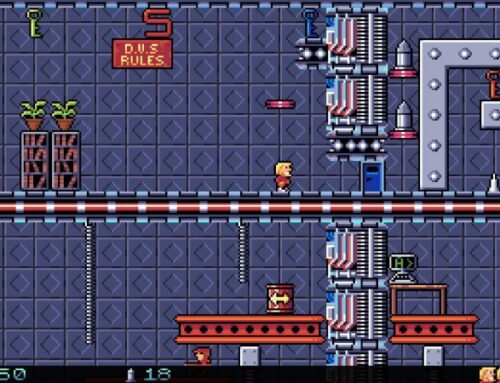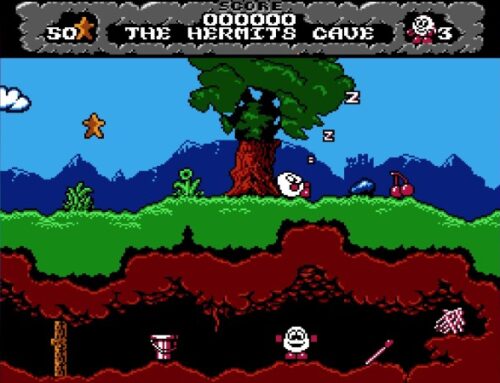We know how it is — when we investigate retro games today we don’t always have the luxury of a manual to teach us exactly how to play. And sometimes that can be a real problem! Our How to Play column explains how to get the best out of some of the more complex retro games out there. Let us know if there are any specific titles you’d like us to cover!
If you’re unfamiliar with Atari 2600 games such as the classic competitive blastathon Air-Sea Battle, you may be surprised to learn that most of them play host to a vast number of game variations, selectable using the Game Select switch on the original console.
And all of these game variations are accessible on modern rereleases and emulated versions of the games, too — for example, on the Evercade versions found on the Atari Collection 1 and Atari Collection 2 cartridges, you can simply press the Select button on the console or controller to choose between them; the number at the top of the screen during the demonstration mode indicates which one you’ve selected.
Trouble is, if you don’t have an original manual with you — or the virtual manual as included in compilations such as Atari Flashback Classics — it can be hard to determine exactly what each variation really is. So with that in mind, we thought we’d help out a bit with some of these classics — beginning with the aforementioned and super-fun Air-Sea Battle.
Air-Sea Battle has 27 different ways to play, which can be split into five broad categories: Anti-Aircraft, Torpedo, Shooting Gallery, Polaris and Bomber. Let’s take a look at each in turn!
Anti-Aircraft

In Air-Sea Battle’s Anti-Aircraft games, up to six aircraft will fly across the top part of the screen, and a new set will not appear until all of the existing targets have been hit. All targets score one point in games 1-3, and different targets have different values in games 4-6.
Using the controller, you can change the angle of your Anti-Aircraft cannon. Push forward/up to aim at a low angle, leave the controller centred to fire at a high angle, and pull back/down to aim directly upwards. Press the fire button to shoot a shot — only one shot per player can be on screen at a time.
Game 1: The game unfolds exactly as described above, with two players competing against one another for points. All targets score one point. First to 99 points or highest score after 2 minutes and 16 seconds wins. Scores will flash for the last 16 seconds to show the end is near.
Game 2: After firing, both players can change the angle their missiles are travelling at by pushing up or down on your controller. This is known as “guided missiles”. Same rules as Game 1 apply.
Game 3: A single-player game against a computer player who fires regularly. Solo players must use the right controller/controller 2.
Game 4: As Game 1, but targets have variable values. Observation blimps are worth no points, large airliners are worth 1 point, helicopters are worth 2 points, large jets are worth 3 points and biplanes are worth 4 points.
Game 5: As Game 4, but with guided missiles.
Game 6: A single-player version of Game 4. Again, solo players must use the right controller/controller 2.
Torpedo

In Air-Sea Battle’s Torpedo games, your “gun” is actually a submarine hiding beneath the waves, and the targets passing above you are enemy ships. This time around, you cannot change the angle of your shot, but you can move left and right by pushing the respective direction on the controller. Pressing the fire button shoots straight upwards.
As with Anti-Aircraft, there are two subsets of Torpedo games — Games 7 to 9 have targets that score one point each, while games 10 to 12 have variable value targets. As with Anti-Aircraft, all games conclude when one player scores 99 points, or after 2 minutes and 16 seconds. During the last 16 seconds, the scores will flash.
Game 7: The most straightforward Torpedo game for two players. All targets worth one point.
Game 8: As above, but “guided missiles” rules apply. This time, as you move left and right, your missile goes with you.
Game 9: Single-player variant. Solo player must use right controller/controller 2.
Game 10: Variable value target variant. Mines are worth no points, freighters are worth 1 point, pirate ships are worth 2 points, aircraft carriers are worth 3 points and PT boats are worth 4 points.
Game 11: Variable value target variant with guided missiles.
Game 12: Single-player variable value target variant. Solo player must use right controller/controller 2.
Shooting Gallery

The Shooting Gallery games in Air-Sea Battle combine elements of both Anti-Aircraft and Torpedo: you can move your gun left and right and also alter its angle of fire by pushing forward or pulling back.
All Shooting Gallery games feature variable-value targets: clowns are worth 1 point, ducks are worth 2 points, rabbits are worth 3 points. All targets in a wave must be hit before a new wave arrives.
Game 13: Shooting Gallery for two players, as described above.
Game 14: Shooting Gallery for two players with guided missiles — though you can only affect the angle by pulling back or pushing forward, not the horizontal position of the shot.
Game 15: Single-player Shooting Gallery. Solo player must use right controller/controller 2.
Polaris

In the Polaris game modes in Air-Sea Battle, you control a ship. You can adjust its speed by pushing forward for high speed, leaving the controller centred for normal speed, and pulling back for slow speed. All shots fire straight upwards but follow your ship’s horizontal position.
In Polaris games, targets have variable values the same as in the variable-value Anti-Aircraft games: airliners are 1 point, helicopters are 2 points, large jets are 3 points, biplanes are 4 points.
Game 16: The game is as described above. You cannot change the speed of your ship (and missile) while a missile is in flight.
Game 17: As above, but you can change the speed of your ship (and missile) while a missile is in flight.
Game 18: Single-player variant, following the rules of Game 16. Solo player must use right controller/controller 2.
Bomber

Air-Sea Battle’s Bomber modes are Polaris, but the other way around. This time you’re a plane at the top of the screen, and your bombs are smaller than the missiles you fire in Polaris. Again, you can adjust your speed by pushing forwards or pulling back, and your bombs follow your plane’s horizontal position while falling.
All targets are variable-value as in the variable-value Torpedo games. Freighters are 1 point, pirate ships are 2, aircraft carriers are 3 and PT boats are 4.
Game 19: The game as described above. You cannot change the speed of your plane (and bomb) while a bomb is falling.
Game 20: As above, but you can change the speed of your plane (and bomb) while a bomb is falling.
Game 21: Single-player variant, following the rules of Game 19. Solo player must use right controller/controller 2.
Polaris vs Bomber

In this competitive mode of Air-Sea Battle, one player pilots the ship from Polaris, the other pilots the plane from Bomber. Each must try to destroy the other. Games 22 to 24 give you a clear shot at one another, while Games 25 to 27 scatter moving mines randomly in your firing line — these are worth no points if hit.
As in both Polaris and Bomber, the speed of your ship or plane can be controlled by pushing forward or pulling back on the controller.
Game 22: Polaris vs. Bomber as described above. You cannot change your speed after firing a missile or dropping a bomb.
Game 23: As above, but you can change your speed while your shot is in flight.
Game 24: Single-player variant where the computer controls the plane. Solo player must use right controller/controller 2.
Game 25: As Game 22, but with mines on the playfield.
Game 26: As Game 23, but with mines.
Game 27: As Game 24, but with mines.
Quick summary
From the original Air-Sea Battle manual.






